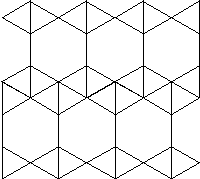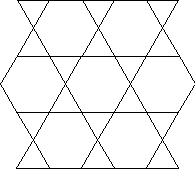Regular Polygon Tessellations II
Objective: To explore tessellations which combine different regular polygons.
Materials: For teaching students, Tessel-Gons are recommended. (Pattern blocks do not
contain octagons or dodecagons.)
The only regular polygons which will tile by themselves are triangles, squares, and
hexagons. If different types of regular polygons are used together, however, other types of
polygons will tessellate. For simplicity, the possibilities will be restricted to tessellations
in which all of the tile edges are the same length. We will consider tessellations known
as edge-to-edge. This means that the full edges (or sides) of two tiles meet. A subset of
all edge-to-edge tessellations is the set of eleven Archimedean tessellations. Three of these
are the aforementioned triangle, square, and hexagon tessellations. The other eight are
sometimes referred to as semi-regular or homogeneous tessellations. The Archimedean
tessellations are edge-to-edge tessellations in which every vertex is of the same type.
Examples are shown below of, respectively, a non-edge-to-edge tessellation, an edge-to-edge
tessellation which is not Archimedean, and an edge-to-edge tessellation which is Archimedean.



The only other regular polygons which can be used in edge-to-edge tessellations are octagons
and dodecagons (twelve-sided polygons).
Try to construct examples of edge-to-edge tessellations using octagons and using dodecagons
which are Archmedean.
Now try to construct the remaining five Archimedean tessellations.
Next, try to construct tessellations which are edge-to-edge but not Archimedean using octagons,
and using dodecagons. You will find that there are none using octagons.
Go to Tessellations Home
Webmaster: Robert Fathauer;
rob@tessellations.com